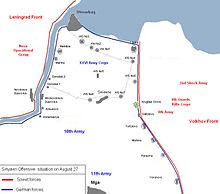
Leonid Aleksandrovich Govorov was a Soviet military commander. Trained as an artillery officer, he joined the Red Army in 1920. He graduated from several Soviet military academies, including the Military Academy of Red Army General Staff. He participated in the Winter War of 1939–1940 against Finland as a senior artillery officer.
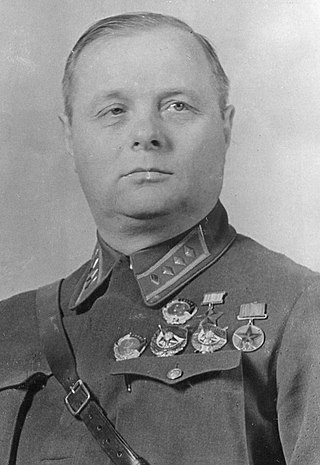
Kirill Afanasievich Meretskov was a Soviet military commander. Having joined the Communist Party in 1917, he served in the Red Army from 1920. During the Winter War of 1939–1940 against Finland, he had the task of penetrating the Mannerheim Line as commander of the 7th Army. He was awarded the title of Hero of the Soviet Union shortly afterwards.
The Battle of Krasny Bor was part of the Soviet offensive Operation Polyarnaya Zvezda in the Eastern Front of World War II. It called for a pincer attack near Leningrad to build on the success of Operation Iskra and completely lift the siege of Leningrad, in the process encircling a substantial part of the German 18th Army. The offensive near the town of Krasny Bor formed the western arm of the pincer. The Soviet offensive began on Wednesday, 10 February 1943, and produced noticeable gains on the first day but rapidly became a stalemate. The strong defense by the Spanish Blue Division and the German SS Polizei Division gave the German forces time to reinforce their positions. By February 13, the Soviet forces had ceased their offensive in this sector.

Operation Iskra, a Soviet military operation in January 1943 during World War II, aimed to break the Wehrmacht's siege of Leningrad. Planning for the operation began shortly after the failure of the Sinyavino Offensive. The German defeat in the Battle of Stalingrad in late 1942 had weakened the German front. By January 1943, Soviet forces were planning or conducting offensive operations across the entire German-Soviet Front, especially in southern Russia; Iskra formed the northern part of the wider Soviet 1942–1943 winter counteroffensive.

The Leningrad–Novgorod strategic offensive was a strategic offensive during World War II. It was launched by the Red Army on January 14, 1944 with an attack on the German Army Group North by the Soviet Volkhov and Leningrad fronts, along with part of the 2nd Baltic Front, with a goal of fully lifting the siege of Leningrad. Approximately two weeks later, the Red Army regained control of the Moscow–Leningrad railway, and on January 26, 1944 Joseph Stalin declared that the siege of Leningrad was lifted, and that German forces were expelled from the Leningrad Oblast. The lifting of the 900-day-long blockade was celebrated in Leningrad on that day with a 324-gun salute. The strategic offensive ended a month later on 1 March, when Stavka ordered the troops of the Leningrad Front to a follow-on operation across the Narva River, while the 2nd Baltic was to defend the territory it gained in pursuit of the German XVI Army Corps.
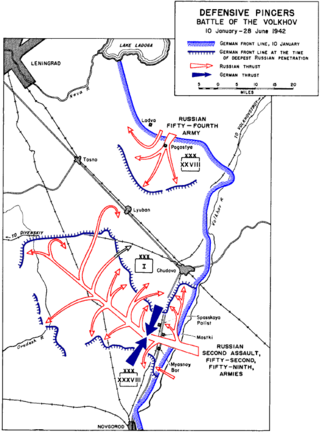
The Battle of Lyuban, Lyuban offensive operation or Battle of the Volkhov was a Soviet offensive operation of World War II. It was conducted by the Volkhov and Leningrad Fronts of the Red Army with the goal of relieving the siege of Leningrad and encircling and destroying the German forces carrying out the siege.
The Red Army's 54th Army was a Soviet field army during the Second World War. It was first formed in the Leningrad Military District in August, 1941, and continued in service in the northern sector of the Soviet-German front until the end of 1944. It spent much of the war attempting to break the German siege of Leningrad, in which it helped to achieve partial success in January, 1943, and complete success one year later. During these operations the soldiers of the 54th served under five different commanders, most notably Col. Gen. Ivan Fedyuninsky in the winter of 1941–42. After helping to drive Army Group North away from Leningrad and into the Baltic states in the first nine months of 1944, the army was deemed surplus to requirements on the narrowing front, and was officially disbanded on the last day of the year.
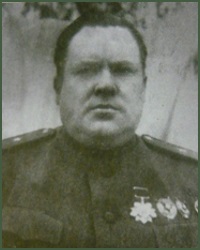
The 310th Rifle Division was a standard Red Army rifle division formed on July 15, 1941 in Kazakhstan before being sent to the vicinity of Leningrad, where it spent most of the war, sharing a similar combat path with its "sister", the 311th Rifle Division. The soldiers of the division fought until early 1944 to, first, hold open some sort of lifeline to the besieged city, then to break the siege and drive off the besieging German forces. They then participated in the offensive that drove Germany's Finnish allies out of the war. Finally, the division was redeployed to take the fight to the German heartland in the winter and spring of 1945. It ended the war north of Berlin with a very creditable combat record for any rifle division.
The 67th Army was a field army of the Soviet Union's Red Army. The 67th Army was formed in October 1942 on the Leningrad Front from the Neva Operational Group. It defended the right bank of the Neva River, holding the Nevsky Pyatachok and covering the Road of Life. In January 1943 the army fought in Operation Iskra. In late December, the army was combined with 55th Army. The 67th Army headquarters was disbanded and 55th Army headquarters was renamed 67th Army headquarters. Between January and March 1944 67th Army fought in the Leningrad–Novgorod Offensive, in which it captured Mga and Luga. In April the army became part of the 3rd Baltic Front and fought in the Pskov-Ostrov Offensive in July and the Tartu Offensive in August and September. The army fought in the Riga Offensive in September and October. The army then fought to eliminate the Courland Pocket. After the end of the war the army was disbanded during the summer of 1945.
The 378th Rifle Division was an infantry division of the Red Army that began forming in August 1941 in the Siberian Military District, before being sent to the vicinity of Leningrad, where it spent most of the war. The soldiers of this division fought until early 1944 to break the siege and drive off the besieging German forces, distinguishing themselves in the liberation of Novgorod. Finally, the division was redeployed to advance into the Baltic states in 1944 and into East Prussia in the winter of 1945. As the war was ending the 378th was disbanded to provide replacements for other divisions. Nevertheless, it had compiled a very creditable combat record for any rifle division.
The 19th Guards Rifle Division was formed from the first formation of the 366th Rifle Division on March 17, 1942. At this time it was in the 52nd Army of Volkhov Front, taking part in the Lyuban Offensive Operation, which was planned to encircle and defeat the enemy forces laying siege to Leningrad. However, just at that time the German 18th Army was in the process of cutting off the Soviet Lyuban grouping in a pocket, and over the following months the division was nearly destroyed. Enough survivors emerged from the swamps in June and July to rebuild the unit, and it fought in the Second Sinyavino Offensive before it was shifted south into Kalinin Front to take part in the battle and siege of Velikiye Luki in December. In the summer of 1943 the 19th Guards fought in the battles for Smolensk, and won its first battle honor, "Rudnya". in September. During the offensive in the summer of 1944 it was awarded the Order of the Red Banner for its successes in the fighting around Vitebsk. It was further honored in February, 1945, with the Order of Lenin for its role in the victories in East Prussia. In the summer the division was moved by rail with its 39th Army to the Far East and saw action in the Soviet invasion of Manchuria in August, winning its second battle honor, "Khingan", for its services. The division continued to see service well into the postwar era.
The 374th Rifle Division was raised in 1941 as an infantry division of the Red Army, and served for the duration of the Great Patriotic War in that role. It began forming in August 1941 in the Siberian Military District. It joined the fighting front in December with the new 59th Army along the Volkhov River and it continued to serve in the fighting near Leningrad until early 1944. The dismal fighting on this front gave little opportunity for a unit to distinguish itself, and the division did not finally earn a battle honor until late January 1944, during the Leningrad–Novgorod Offensive. It continued to serve in the summer and autumn offensive through the Baltic States, becoming so reduced in strength that its remaining infantry was consolidated into a single understrength regiment which nevertheless won a battle honor in the liberation of Riga. The 374th ended the war in Latvia, helping to contain and reduce the German forces trapped in the Courland Pocket, and was disbanded shortly thereafter.
The 376th Rifle Division was raised in 1941 as an infantry division of the Red Army, and served for the duration of the Great Patriotic War in that role. It began forming in August 1941 in the Siberian Military District. It followed a very similar combat path to that of the 374th Rifle Division. It joined the fighting front in December with the new 59th Army along the Volkhov River and it continued to serve in the battles near Leningrad until early 1944. The division took horrendous casualties in the combat to create and hold open a passage to the 2nd Shock Army during the Lyuban Offensive and was itself partly or fully encircled at several times during this dismal fighting. The division finally left this region as it advanced during the Leningrad–Novgorod Offensive in January 1944 and in July won a battle honor in the liberation of Pskov, while its 1250th Rifle Regiment was awarded the Order of the Red Banner. In October the 376th as a whole would also receive the Red Banner for its part in the liberation of Riga. The division ended the war in Latvia, helping to contain and reduce the German forces trapped in the Courland Pocket, and was reorganized as a rifle brigade shortly thereafter.
The 379th Rifle Division was raised in 1941 as an infantry division of the Red Army, and served for the duration of the Great Patriotic War in that role. It began forming in August 1941 in the Urals Military District. It first served in the winter counteroffensive west of Moscow, and later in the bitter fighting around the Rzhev salient, but was moved north late in 1942. It took up positions along the Volkhov River, mostly under command of the 8th Army, and continued to serve in this Army's battles near Leningrad until September 1943, when it was transferred to the 2nd Baltic Front, where it would stay for the remainder of its service. During this period the division served under many army and corps commands but mostly in the 3rd Shock Army. The division ended the war in Lithuania, helping to contain and reduce the German forces trapped in the Courland Pocket. By this time it was judged as being surplus to the Red Army's needs and in December 1944 its personnel were merged with the 245th Rifle Division to bring that division closer to establishment strength; the latter division also inherited its battle honor. The 379th was officially disbanded on the first day of 1945.
The 382nd Rifle Division was raised in 1941 as an infantry division of the Red Army, and served for the duration of the Great Patriotic War in that role. It began forming on August 10 in the Siberian Military District. It joined the fighting front in December with the new 59th Army along the Volkhov River. Apart from a few weeks in 1944 the division served in either the Volkhov Front or the Leningrad Front for the entire war. It suffered horrendous casualties after being encircled in the swamps and forests near Lyuban and was severely understrength for many months afterwards while serving on a relatively quiet front. It remained in the line in the dismal fighting near Leningrad until early 1944 with little opportunity to distinguish itself, and the division did not finally earn a battle honor until late January, 1944, during the Leningrad–Novgorod Offensive. Following this the division was moved to the Karelian Isthmus and entered the summer offensive against Finland in the reserves of Leningrad Front before being assigned to the 23rd Army. Following the Finnish surrender it was redeployed westward, helping to mop up pockets of enemy forces in the Baltic states in early 1945. The 382nd ended the war in Latvia, helping to contain and reduce the German forces trapped in the Courland Pocket, and was officially disbanded in February, 1946.

The Mga offensive or Third Battle of Lake Ladoga or fifth Sinyavino offensive was an unsuccessful offensive operation by Soviet troops between 22 July and 25 September 1943 to break the siege of Leningrad.
The 239th Rifle Division was formed as an infantry division of the Red Army after a motorized division of that same number was reorganized in the first weeks of the German invasion of the Soviet Union. It was based on the shtat of July 29, 1941, and remained forming up and training in Far Eastern Front until early November when the strategic situation west of Moscow required it to be moved by rail to Tula Oblast where it became encircled in the last throes of the German offensive and suffered losses in the following breakout. When Western Front went over to the counteroffensive in the first days of December the division was in the second echelon of 10th Army and took part in the drive to the west against the weakened 2nd Panzer Army. As the offensive continued it took part in the fighting for Belyov and Sukhinichi before being subordinated to the 1st Guards Cavalry Corps in January 1942 to provide infantry support. It then became involved in the complicated and costly battles around the Rzhev salient as part of 50th, 10th and 31st Armies until December. It was then moved north to Volkhov Front, and took part in several operations to break the siege of Leningrad, mostly as part of 2nd Shock and 8th Armies. As part of 59th Army it helped to drive Army Group North away from the city and was rewarded with the Order of the Red Banner in January 1944. During the following months it continued to advance through northwestern Russia but was halted by the defenses of the Panther Line in April. The division took part in the advance through the Baltic states in the summer of 1944 but in February 1945 it was transferred to 1st Ukrainian Front, rejoining 59th Army as part of 93rd Rifle Corps and fought in upper Silesia. In the last weeks of the war the 239th was advancing on Prague, but despite its distinguished record it was selected as one of the many divisions to be disbanded during the summer of 1945.
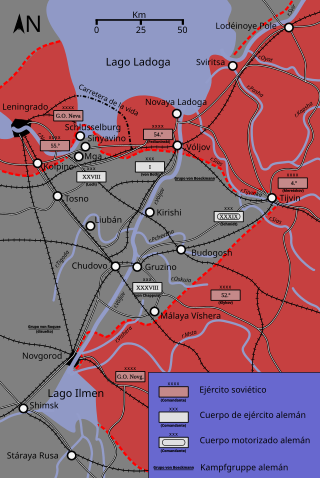
The Tikhvin Offensive was a military operation undertaken by the German army in October 1941 during World War II in the course of Operation Barbarossa. The offensive, conducted entirely around the Volkhov River, was launched by Adolf Hitler with the primary objective of cutting off the supply routes supplying Leningrad. In addition, the German high command intended the deployment of troops in the region to cover the northern flank of the parallel offensive that the Third Reich was launching towards Moscow at that time and also to link up with the allied forces in Finland. The powerful Soviet counteroffensives, added to the accumulated attrition of the German army and the overextension of its logistic network, led to the collapse of the Army Group Norths and the German withdrawal from the occupied ground in the succession of combats.
The 259th Rifle Division was formed from reservists as a standard Red Army rifle division, very shortly after the German invasion, in the Moscow Military District. It was largely based on what would become the shtat of July 29, 1941. It was assigned to the 34th Army of Reserve Front before the end of July, but this Army was soon reassigned to Northwestern Front. Under these commands it took part in the Staraya Russa offensive operation in August. It suffered significant casualties in its first operation but after falling back toward Leningrad it took part, as part of 52nd Army, in both the defense of Tikhvin and the following counteroffensive that retook the city in one of the first major German reverses. In the new year the 259th was involved in the Lyuban offensive, mostly under command of the ill-fated 2nd Shock Army, and this struggle continued into June. Enough of the division escaped encirclement that it avoided disbandment, and it was sufficiently restored by late August that it was committed to the second Sinyavino offensive, eventually becoming encircled again and forced to break out, at considerable cost. In early October it was withdrawn to the Reserve of the Supreme High Command for a lengthy period of restoration, well into 1943, in 2nd Reserve Army, as it moved well to the south.
The 198th Rifle Division was formed as an infantry division of the Red Army after a motorized division of that same number was reorganized in the first months of the German invasion of the Soviet Union. It was based on the shtat of July 29, 1941, with several modifications. It entered combat as a rifle division during the Tikhvin Offensive in December 1941 as a reinforcement for 54th Army, helping to drive elements of Army Group North back to the Volkhov River from their earlier gains. It would remain near that river line into early 1944. During 1942 it took part in several abortive offensives in an effort to relieve the siege of Leningrad, suffering heavy losses in one of them. In 1943 it was mainly used for line-holding duties at a reduced establishment, in an area where German forces were strictly on the defensive. The 198th was brought back up to something approaching the current establishment by the start of 1944 and, during the offensive that finally drove Army Group North away from Leningrad, it helped to maintain the offensive's momentum following the initial breakthrough as part of 119th Rifle Corps. It was finally reassigned to 3rd Baltic Front's 67th Army in April after it was halted at the Panther Line near Pskov. In August it briefly returned to 54th Army during the advance through the Baltic States, and after the capture of Riga it remained in western Latvia for the duration of the war, serving under several commands, mostly the 42nd and 10th Guards Armies. It was one of the very few divisions that served throughout the war without receiving any battle honors or decorations. Despite this, the 198th continued its service, now in western Siberia, for another 10 years, before being redesignated as the 23rd Rifle Division.

